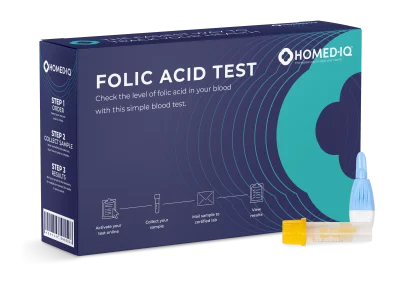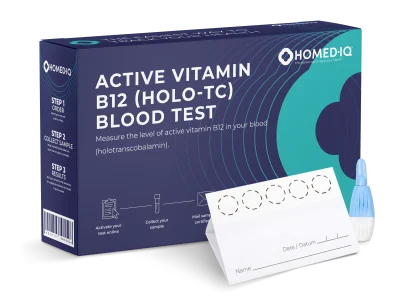Hemoglobin (Hb) is part of the red blood cells in our body. It is important to maintain a healthy hemoglobin level to feel our best and ensure our body can function properly. When our hemoglobin value is too high or too low, physical complaints can arise.
What is hemoglobin?
Hemoglobin is a protein that allows for the absorption and transport of oxygen and carbon dioxide in red blood cells. The red blood cells in our body ensure the delivery of oxygen from the lungs to our body’s cells. Oxygen allows your muscles and organs to obtain energy from the food you eat, also known as cellular respiration. After the oxygen is released to the cells, hemoglobin is then able to absorb carbon dioxide which ends up in the lungs. The carbon dioxide then leaves the body through exhalation (Sanquin).
Why is hemoglobin important?
Hemoglobin is important because it carries oxygen from the lungs to the tissues of the body and removes carbon dioxide. This is an essential process that occurs every moment of the day. Adequate hemoglobin levels contribute to optimal functioning of your body cells and ensures the removal of waste products.
What is an optimal hemoglobin value?
The reference values for hemoglobin are as follows: (Dutch Association of Hematology):
- Men: 8.5 – 11 mmol/l
- Women: 7.5 – 10 mmol/l
- Children > 6 years: 6.5 – 10 mmol/l
- Children 1 month – 6 years: 6 – 9 mmol/l
Can your hemoglobin be too high or too low?
Yes- if your hemoglobin level is too low, you may have anemia. This means you don’t have enough healthy red blood cells to carry adequate oxygen to your body’s cells. There are various causes for this, such as kidney failure, a stomach ulcer, chemotherapy, or nutritional and vitamin deficiencies.
If your hemoglobin level is too high, your blood does transport enough oxygen, but there is an increased risk of clots. These clots can form because the blood is more viscous, which can lead to narrowing or blockage of arteries (Isala Zwolle, 2021).
What are the causes of a low hemoglobin level?
Anemia occurs when there is too little hemoglobin in the blood. This can be caused by several factors ( Máxima MC, 2022 ):
- Iron deficiency
- Deficiency of vitamin B12 or folic acid
- Hereditary form of anemia, such as thalassemia
- Resulting from of another disease
Would you like to get an overview for yourself?
With the Active Vitamin B12 (Holo-TC) Test and the Folic Acid Test from Homed-IQ, you can check from the comfort of your own home whether you have a deficiency of these important nutrients.
-

Folic Acid Test
€45,00 -

Active Vitamin B12 (Holo-TC) Test
€45,00
What happens if your hemoglobin is too low?
If the hemoglobin level is too low, you have anemia. This can cause the following symptoms:
- Fatigue
- Pale skin
- Heart palpitations
- Headache
- Hair loss
- Shortness of breath
- Headache
- Cold feet and hands
- Chest pain
How do I increase my hemoglobin level?
When you have low hemoglobin, it is important to consume more iron. There is iron in all kinds of foods, such as meat, fish, chicken, legumes, and vegetables such as spinach. It is also possible to use an iron supplement. It is advisable to check your hemoglobin level a few months after making dietary changes to see if any improvements have been made. Contact your GP if you require more advice on how to increase your hemoglobin level.
References
Bloedarmoede – Máxima MC. (2017, September 27). Interne Geneeskunde. https://www.mmc.nl/internegeneeskunde/aandoeningen-en-behandelingen/bloedarmoede/?_ga=2.252499337.1416331597.1669584503-555177933.1667906179
Isala. (2021, November). Hematologische aandoening (PID): H2 Optionele bijlage Myeloproliferatieve aandoeningen. https://www.isala.nl/patientenfolders/6551-hematologische-aandoening-pid-h2-optionele-bijlage-myeloproliferatieve-aandoeningen/?_ga=2.152885433.1416331597.1669584503-555177933.1667906179
Nederlandse Internisten Vereniging. (2020, January 30). Normaalwaarden ». https://hematologienederland.nl/patientinfo/diagnose-en-behandeling/normaalwaarden/?_ga=2.152885433.1416331597.1669584503-555177933.1667906179
Wat is hemoglobine en welke waarde is normaal? | Sanquin. (n.d.). https://www.sanquin.nl/. https://www.sanquin.nl/over-bloed/eiwitten/hemoglobine?gclid=CjwKCAiA9tyQBhAIEiwA6tdCrFiDOf8-HC_ZusmDi4mgn-M8LMrAeJTEQjFZNKA6m88-2BvbsODVIBoC7hEQAvD_BwE






